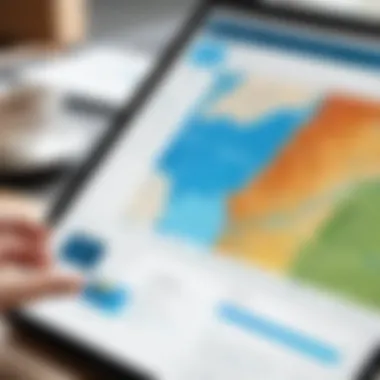Understanding ArcGIS Software Pricing Explained


Intro
Understanding the pricing mechanisms of ArcGIS software is vital for organizations aiming to leverage geospatial analysis. This software, renowned for its robust functionalities and versatility, presents diverse pricing options that can often confuse potential users. Getting a firm understanding of these costs, with their influences and comparisons, enables decision-makers to evaluate their options and choose wisely.
Geolocation technology has seen a rapid ascent, driving demand for tools like ArcGIS in both public and private sectors. From urban planning to resource management, the applications of this software are boundless. However, the complexity of its pricing can be daunting. This article aims to dissect the pricing structures, highlight key features, and analyze cost factors, guiding buyers towards informed decisions.
Key Features and Functionalities
Comprehensive Overview
ArcGIS provides a multitude of features designed to cater to various geospatial needs. These include advanced mapping capabilities, spatial analysis tools, and the ability to create interactive web maps. Using ArcGIS Online, users can share data easily, while ArcGIS Pro offers high-level analytics that leverage 3D visualization.
Here are some core functionalities of ArcGIS:
- Mapping Tools: Users can create detailed maps using extensive data layers.
- Spatial Analysis: Allowing complex queries to understand spatial relationships.
- Data Management: Supports large datasets with various formats.
- Collaboration Features: Enables teams to work on projects together seamlessly.
Target Users
Various sectors utilize ArcGIS for its capability to handle geospatial data effectively. The target users include government agencies, environmental organizations, academic institutions, and commercial enterprises. Each user group may have specific needs that ArcGIS addresses, such as land use planning for government bodies, or resource allocation for corporate firms.
Pricing Models and Cost Analysis
Breakdown of Pricing Tiers
ArcGIS operates on a tiered pricing model. Licensing options include both subscription-based and perpetual licenses. The software is structured to offer packages that serve different levels of need.
- ArcGIS Online: Accessibility via subscription, often preferred for its flexibility.
- ArcGIS Pro: Available through a license, typically recommended for high-demand analytics.
- Enterprise Solutions: Tailored for organizations needing extensive user rights and functionalities at scale.
Each tier has specific functionalities that may appeal to different users.
Additional Costs to Consider
Apart from the primary licensing fees, several costs may arise when using ArcGIS:
- Training and Support: Organizations may need to invest in training for employees.
- Maintenance Fees: Annual renewal costs can impact budgeting.
- Add-Ons and Customizations: Extra features may require separate purchases.
Investing in ArcGIS without understanding its pricing potential can lead to unexpected expenses, challenging the initial budget.
In summary, the pricing structure of ArcGIS is not just about the license fees. It includes understanding the complete cost of ownership over time, considering additional costs alongside the core functionalities. By evaluating these aspects, organizations can make strategic decisions when integrating ArcGIS into their operations.
Preface to ArcGIS Software
Understanding ArcGIS software is crucial for any organization looking to leverage geospatial data. As a leading platform in geographic information systems (GIS), ArcGIS supports various industries in analyzing and visualizing maps and spatial data. This software enables better decision-making based on geographic insights.
Organizations should consider ArcGIS for its ability to integrate data across different sources. This integration facilitates complex analyses that can reveal patterns not easily observable through other means. Companies can optimize operations, improve outreach, and develop strategies that utilize location intelligence effectively.
Another benefit of ArcGIS is its scalability. From small businesses to large enterprises, the platform can be tailored to fit specific needs. As organizations grow, their geospatial needs may evolve, and ArcGIS provides the flexibility required to adapt to these changes.
In summary, understanding ArcGIS software offers two key advantages: improved data analysis capabilities and the ability to scale as per business requirements. This knowledge lays the foundation for exploring pricing structures in the subsequent sections.
Overview of ArcGIS
ArcGIS is a comprehensive software framework developed by Esri. It provides tools for mapping, analysis, data management, and visualization. Users can collect, analyze, and share spatial data seamlessly. This makes it a versatile option for professionals across diverse fields.


The software operates on a modular basis. Users can choose specific tools or products based on their requirements. For example, ArcGIS Online offers cloud-based operations, while ArcGIS Pro provides advanced analytical capabilities in a desktop environment.
By enabling users to visualize data spatially, ArcGIS transforms raw information into interactive maps. This enhances the understanding of complex datasets. Users can identify trends, patterns, and relationships in the data, leading to informed decisions.
Applications of ArcGIS
The applications of ArcGIS are extensive and varied. Across sectors like urban planning, environmental management, transportation, and health, organizations are harnessing its capabilities to drive decision-making.
- Urban Planning: City planners use ArcGIS to visualize demographic trends and infrastructure. This helps ensure sustainable development.
- Environmental Management: The tool aids in studying environmental impacts, improving conservation efforts, and facilitating effective resource management.
- Transportation: Agencies employ ArcGIS to analyze traffic patterns, optimize routes, and plan future projects efficiently.
- Healthcare: The software provides insights into population health trends and resource allocation based on geographic locations.
Adopting ArcGIS can lead to improved operational efficiency and data visualization, supporting better strategic planning. Its flexibility makes it suitable for both niche projects and expansive studies.
Pricing Models for ArcGIS Software
Understanding the pricing models for ArcGIS software is crucial for anyone considering investment in this powerful geospatial tool. The various models directly influence not only the overall cost but also the flexibility and scalability of usage for organizations. Different businesses will have different requirements, potentially changing the outlook on what pricing model is most appropriate.
Subscription-Based Pricing
Subscription-based pricing has gained significant traction in recent years. This model allows users to pay for ArcGIS software on a periodic basis, usually monthly or annually. One critical advantage of this model is its flexibility. Organizations can adapt their subscriptions based on project needs or budget constraints. Additionally, users receive updates and new features without incurring any additional costs.
However, this method can accumulate costs over time, sometimes making it more expensive in the long term. Users must also evaluate the number of licenses needed, as the price per license may decrease with more users.
“Subscription pricing offers a model that aligns well with rapid changes in technology and user needs.”
Perpetual Licensing Costs
Perpetual licensing represents a more traditional form of software pricing. Under this model, users purchase the software outright, leading to full ownership. Once the initial payment is made, the software can be used indefinitely. This model suits organizations that prefer a one-time payment without ongoing expenses.
Nonetheless, there are some important considerations. First, the upfront cost can be significant compared to subscription models. Users also need to plan for future upgrades; although they own the software, they may need to pay separately for new versions. Additionally, support services often come with extra costs. Users must weigh the benefits of long-term ownership against initial cost factors and long-term needs.
Enterprise Licensing Agreements
Enterprise licensing agreements cater to larger organizations with extensive software needs. These agreements provide a customized approach, often at a reduced cost compared to standard licenses. They allow for unlimited or extensive access based on the agreed terms.
This model is beneficial for companies with many users requiring access to the software. It can significantly lower per-user fees and create a more controlled environment for managing licenses. However, negotiation and management of these agreements can be complex, requiring careful consideration of the organization's future growth and its evolving software demands.
In summary, understanding the variants in pricing models is essential for making informed decisions. Knowing the implications of subscription, perpetual, and enterprise licensing options empowers organizations to select the best approach tailored to their unique operational strategies.
Key Factors Affecting ArcGIS Pricing
Understanding the pricing of ArcGIS software is crucial for organizations aiming to utilize geospatial technology effectively. Numerous factors can influence the final cost. Recognizing these elements can guide decision-makers and IT professionals in their purchasing strategies. The following key factors are essential in shaping the overall pricing landscape of ArcGIS software.
Geographic Variations
Geographic location can drastically affect the pricing of ArcGIS. Different countries and regions may experience variations due to local economic conditions, taxation, and demand for geospatial services. In countries with a strong demand for GIS technology, the cost may be higher due to market saturation and enhanced functionalities. Furthermore, Esri, the company behind ArcGIS, often tailors pricing models to align with local pricing strategies. It means that users must consider their geographic location when evaluating costs. This factor can also influence availability and the specific features included in the licensing models.
User Requirements and Customization
Each organization has unique needs that can significantly affect the overall cost of ArcGIS. User requirements can range from basic mapping functionalities to complex spatial analysis tools. The willingness to invest in customization can lead to additional expenses. Organizations aiming to integrate ArcGIS into existing systems must account for these factors during budget planning. Licensing tiers may offer different levels of access and capabilities, which often correlate with the user's specific demands. Choosing the right features and understanding potential customizations is key to achieving a good balance between functionality and cost.
Training and Support Services
Implementation of ArcGIS is not solely about purchasing software. Effective utilization necessitates thorough training and ongoing support services. Organizations should anticipate additional costs associated with training personnel to use the software effectively. Local training sessions, additional materials, or expert consultations can elevate overall expenditure. Moreover, adequate support services are critical for management, updates, and troubleshooting. Investing in training can maximize the return on investment, so it must be factored into the total cost of ownership.


It is vital to view the total cost of acquisition as more than just the price of the software itself.
In sum, understanding the factors that affect ArcGIS pricing enables organizations to make informed purchasing decisions. Each factor contributes to the total expenditure, and recognizing their implications can aid in creating a tailored strategy suitable for varying organizational needs.
Comparative Analysis with Competitors
The comparative analysis with competitors is crucial in understanding ArcGIS’s position in the market. This section provides a detailed examination of ArcGIS software against prominent alternatives such as QGIS and MapInfo. The significance lies in assessing different pricing structures, features, and user experiences that can influence purchasing decisions. By analyzing these competitors, potential buyers can identify which software best aligns with their needs and budgets.
ArcGIS vs. QGIS
ArcGIS and QGIS represent two distinct approaches to geospatial analysis. ArcGIS is known for its extensive functionalities and user support, often preferred by organizations with substantial budgets. In contrast, QGIS operates on an open-source model, appealing to users seeking cost-effective solutions without sacrificing essential features.
- Pricing: ArcGIS generally requires a subscription or perpetual license, which can lead to high initial costs. On the other hand, QGIS is free to use, though users may incur expenses for training or specialized plugins.
- Functionality: ArcGIS offers advanced capabilities such as real-time data processing and cloud integration. QGIS provides robust features but may not match the depth of tools available in ArcGIS. Still, it covers basic to moderate geospatial tasks effectively.
- User Interface: Users often find ArcGIS’s interface more polished and user-friendly; however, QGIS has improved significantly over recent versions. The choice may depend on whether users prioritize support or customizability.
- Community Support: While ArcGIS has dedicated customer service, QGIS benefits from a strong open-source community, providing diverse resources and forums for troubleshooting.
ArcGIS vs. MapInfo
MapInfo and ArcGIS also provide powerful geospatial tools, each with its strengths. ArcGIS is often favored in extensive enterprise applications, whereas MapInfo may cater better to specific industries.
- Pricing Structure: MapInfo's licensing is competitive with ArcGIS but typically offers lower initial costs for smaller organizations. However, long-term expenses can add up depending on feature needs and user licenses.
- Features: ArcGIS excels in a comprehensive toolkit, integrating various advanced technologies and extensive data sources. MapInfo may offer a simpler solution, focusing on business-oriented mapping and spatial analysis functionalities, appealing to users within specific sectors like real estate and urban planning.
- Target User Base: ArcGIS often attracts larger businesses or government contracts, given its extensive feature set. MapInfo, however, can be the preferred choice for smaller firms or specific markets looking for efficient and easier navigation through spatial data.
- Learning Curve: Generally, users experience a steeper learning curve with ArcGIS due to its complexity, while MapInfo tends to facilitate quicker adaptation for new users, especially those in niche industries.
In summary, the decision between ArcGIS and MapInfo depends on the intended application and industry focus. Organizations should scrutinize which tools best fit their operational needs and budget constraints.
User Feedback and Experience
Understanding user feedback and experience is crucial in analyzing ArcGIS software pricing. It goes beyond numbers and provides insights into how effectively the software meets the real-world needs of its users. The feedback can influence decision-making among potential buyers. A thorough understanding of these perspectives can help buyers grasp the value associated with the costs.
Case Studies on Pricing Decisions
Case studies provide concrete evidence regarding how organizations analyze pricing models when choosing ArcGIS. Different organizations face diverse challenges and therefore, their decisions may reflect those unique situations. For example, a municipal planning department might favor a subscription model due to budgeting constraints, while a large engineering firm may opt for a perpetual license for long-term projects.
- Example 1: A regional government agency needed to analyze environmental data more frequently. They decided on the subscription model of ArcGIS, allowing flexibility in their payments, and benefitted from the latest features without heavy upfront investments.
- Example 2: A consulting company required extensive customization. They found that investing in a perpetual license provided greater long-term savings and better alignment with their bespoke needs.
Through these examples, it becomes clear that understanding the specific pricing choices can significantly influence the overall success of implementation and user satisfaction.
Customer Satisfaction and ROI
Customer satisfaction serves as a gauge for the effectiveness of ArcGIS software relative to its cost. Satisfaction does not simply refer to a pleasant experience; it involves users feeling that the value they receive justifies their expenditure. Return on investment (ROI) is often measured in terms of efficiency gains and improved outcomes attributable to the software.
- Key Metrics:
- Feedback Data:
Many users report improved workflow integration and data management, reinforcing the perceived value of ArcGIS.
- Reduction in time required for project completion
- Increased accuracy in spatial analyses
However, return on investment can vary, and some organizations might face challenges in quantifying it. In such scenarios, qualitative feedback becomes paramount. Users articulating specific improvements can provide invaluable context to the pricing discussion. This can, in turn, help potential buyers understand how previous users have managed their investments effectively.
"Customer experience is not just a measure of satisfaction, but a source of competitive advantage in the marketplace."
Decisions about ArcGIS software pricing will ultimately hinge on an understanding of user feedback and experiences. This information can guide strategic choices, ensuring that organizations select a pricing model that optimally fits their goals and resources.
Budgeting for ArcGIS Software
Budgeting for ArcGIS software is a crucial aspect of any organization’s planning process. Successful budgeting enables businesses to allocate the right amount of resources to various projects, ensuring that geospatial analysis tools can be accessed without financial strain.
The relevance of budgeting becomes clear when businesses consider their long-term goals. When organizations fail to properly budget, they may find themselves overspending or underutilizing their resources. In addition, understanding costs related to ArcGIS can lead to more effective project planning and execution, maximizing the return on investment. A well-structured budget not only enables informed decision-making but also enhances the overall efficiency of an organization.


Establishing a Budget
Setting a budget involves several steps. Organizations must first assess their needs for ArcGIS software within their operations. Identifying specific projects that will utilize the software provides clarity on the necessary features and capabilities.
Next, organizations should research the pricing models available. This means examining whether a subscription-based model or perpetual licensing works better for their situation. It's important to consider:
- The size of the team using ArcGIS.
- The frequency of updates and support needed.
- Any additional training or resources that may be required.
Additionally, building flexibility into the budget is essential. Costs associated with software can fluctuate based on user needs, technology updates, and changes in business direction. A flexible budget allows a company to adapt to changes without compromising on quality or functionality.
Cost-Benefit Analysis
Conducting a cost-benefit analysis is another vital part of budgeting for ArcGIS software. This process involves examining the potential benefits derived from using ArcGIS against the investment needed to acquire it.
A proper analysis may include:
- Tangible Benefits: These usually relate to direct financial returns and include factors such as increased productivity and efficient data handling.
- Intangible Benefits: These are harder to quantify but can greatly impact an organization. Enhanced decision-making capabilities, improved team collaboration, and better strategic planning often arise from using advanced geospatial tools.
Blockquote
"A careful cost-benefit analysis can illuminate the path forward, balancing financial constraints with the potential for growth and efficiency.”
By understanding both costs and benefits, organizations are better equipped to make informed choices. This ultimately leads to optimized budget allocation, ensuring that investments in software like ArcGIS yield valuable results.
Future Trends in ArcGIS Pricing
Understanding future trends in ArcGIS pricing is essential for organizations and individuals making budgetary decisions. As technology evolves, so do pricing strategies. This section looks at how emerging pricing strategies and technological advancements can affect costs associated with ArcGIS. Recognizing these trends allows for better financial planning and investment in geospatial technologies.
Emerging Pricing Strategies
Emerging pricing strategies for ArcGIS are increasingly being driven by market dynamics and user demands. As the software becomes integral to various sectors, enterprises are looking for cost-effective options.
- Value-based Pricing: Companies may adopt a value-based pricing model. This approach means that prices are set based on the perceived value of the software to the end-user rather than simply the cost of development. It aligns pricing with outcomes that users can achieve.
- Tiered Pricing Models: Tiered pricing offers different levels of service or features at varying price points. This gives flexibility to consumers, allowing them to choose a package that matches their needs and budgets. For example, ArcGIS may provide three tiers: basic, standard, and premium. Each level would differ in capabilities and costs.
- Pay-as-you-go Models: Another emerging strategy is the pay-as-you-go model. Users pay for what they use rather than a flat fee. This can make it easier for smaller organizations to access sophisticated tools without the financial burden of full licenses.
Adopting these strategies may require changes in how existing customers view pricing. Organizations need to evaluate their specific requirements to choose the most fitting model.
Impact of Technological Advancements
Technological advancements are reshaping not only how ArcGIS is used but also its pricing structure. The integration of cloud computing and mobile technology is significant.
- Cloud-based Services: As more users move to cloud solutions, pricing for ArcGIS may shift towards subscription models that offer lower upfront costs. Users benefit from having real-time access to the software without investing heavily in IT infrastructure.
- AI and Machine Learning Integration: The incorporation of artificial intelligence can enhance analytical capabilities, leading to new pricing structures that reflect these advanced features. Users may pay more for enhanced functionalities that improve operational efficiency.
- Increased Collaboration Tools: With proliferation of remote work, GIS software is evolving with features that allow for enhanced collaboration among users. Pricing could reflect these enhanced features that support teamwork.
Closure
The conclusion of this article on ArcGIS software pricing encapsulates the intricate nature of its various pricing structures and the factors that affect these costs. Understanding the pricing strategies of ArcGIS is critical for organizations aiming to deploy geospatial analysis tools effectively. Knowing the differences in pricing models, such as subscription-based and perpetual licensing, allows decision-makers to identify which structure aligns with their budget and project needs. Additionally, those looking into ArcGIS should take note of geographic variations and user-specific requirements that can significantly influence overall expenditure.
Final Thoughts on Pricing Strategies
Pricing strategies in software, especially with complex tools like ArcGIS, are not simply about numbers. They reflect underlying value propositions and the costs of maintaining software services. The transition to subscription models, for example, offers flexibility but can lead to higher long-term costs if not managed well. Firms must evaluate their needs to decide if they prefer the predictability of a subscription or the one-time payment of a perpetual license. Similarly, enterprise licensing agreements can provide bulk discounts, which might be advantageous for larger teams.
Concluding, it is essential to analyze how each pricing model can fit your organization and if the benefits outweigh the costs. This analysis should consider future growth, the potential need for customization, and ongoing support services that may escalate costs.
Recommendations for Buyers
For potential buyers of ArcGIS software, careful consideration is necessary when selecting a pricing model. Here are some recommendations to guide the decision-making process:
- Assess Organizational Needs: Evaluate your specific requirements and future demands before choosing a pricing structure. Determine if the organization will need extensive customization or will likely scale in the future.
- Consider Total Cost of Ownership: Look beyond the sticker price of ArcGIS. Factor in training, support services, and possible upgrades when calculating total costs.
- Explore Trial Options: Where possible, take advantage of trial periods to better understand the software's applicability and value before committing to a long-term purchase.
- Stay Informed on Emerging Trends: Technology is always evolving. Keeping an eye on emerging pricing strategies can help in selecting the most equitable option as your needs change.
- Engage User Communities: Networking within user forums like those found on websites such as Reddit can provide invaluable insights from current users about their experiences and choices regarding pricing.
By addressing these key considerations, you can ensure that your investment in ArcGIS software will be beneficial not just for today, but for your organization's future as well.
"Understanding the price structures will allow organizations to make decisions that are not only economically sound but also strategically aligned with their long-term goals."















